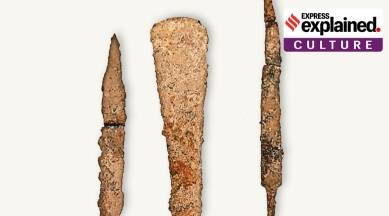Context:
Carbon dating of excavated finds in Tamil Nadu pushes evidence of iron being used in India back to 4,200 years ago, the Tamil Nadu government announced this week on the basis of an archaeological report.

Relevance:
GS I- Art and Culture
Dimensions of the Article:
- Iron being used in India back to 4,200 years
- Findings
- Iron age in India
- Historical significance
- Culture and politics
Iron being used in India back to 4,200 years
- Carbon dating of excavated finds in Tamil Nadu pushes evidence of iron being used in India back to 4,200 years ago, the Tamil Nadu government announced this week on the basis of an archaeological report.
- Before this, the earliest evidence of iron use was from 1900-2000 BCE for the country, and from 1500 BCE for Tamil Nadu.
- The latest evidence dates the findings from Tamil Nadu to 2172 BCE.
Findings
- The excavations are from Mayiladumparai near Krishnagiri in Tamil Nadu, about 100 km south of Bengaluru. Mayiladumparai is an important site with cultural material dating back between the Microlithic (30,000 BCE) and Early Historic (600 BCE) ages.
- The site is situated in the midst of several archaeological sites such as Togarapalli, Gangavaram, Sandur, Vedarthattakkal, Guttur, Gidlur, Sappamutlu and Kappalavadi
Iron age in India:
- The dates when humans entered the Iron Age vary from one region of the world to another.
- In India, too, the date has been revised with successive findings over the decades.
- In 1979, use of iron was traced to 1300 BCE at Ahar in Rajasthan.
- Later, samples at Bukkasagara in Karnataka, indicating iron production, were dated back to 1530 BCE.
- The date was subsequently pushed back to 1700-1800 BCE with excavations finding evidence of iron smelting at Raipura in the Mid-Ganga valley, and then to 1900-2000 BCE based on investigations in sites at Malhar near Varanasi and Brahmagiri in North Karnataka.
- A series of dating results on finds from various parts in India have shown evidence of iron-ore technology before 1800 BCE.
- Before the latest discovery, the earliest evidence of iron use for Tamil Nadu was from Thelunganur and Mangadu near Mettur, dating back to 1500 BCE.
Historical significance
- Iron is not known to have been used in the Indus Valley, from where the use of copper in India is said to have originated (1500 BCE).
- But non-availability of copper for technological and mass exploitation forced other regions to remain in the Stone Age.
- When iron technology was invented, it led to the production of agricultural tools and weapons, leading to production required for a civilisation ahead of economic and cultural progress.
- While useful tools were made out of copper, these were brittle and not as strong as iron tools would be.
- With the latest evidence tracing our Iron Age to 2000 BCE from 1500 BC, we can assume that our cultural seeds were laid in 2000 BCE.
- And the benefit of socio-economic changes and massive production triggered by the iron technology gave its first fruit around 600 BCE — the Tamil Brahmi scripts.
Culture and politics
- The Tamil Brahmi scripts were once believed to have originated around 300 BCE, until a landmark finding in 2019 pushed the date back to 600 BCE.
- This dating narrowed the gap between the Indus Valley civilisation and Tamilagam/South India’s Sangam Age. This, and the latest findings, are politically significant.
- The dating of the scripts, based on excavations from sites including Keeladi near Madurai, became controversial when the Archaeological Survey of India (ASI) did not go for advanced carbon dating tests, and an ASI researcher who had initiated the study was transferred out of the state.
Source: Indian Express




